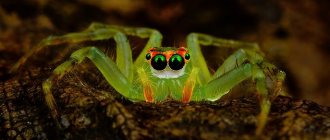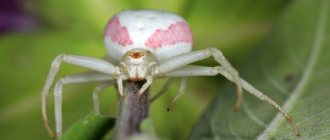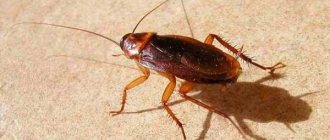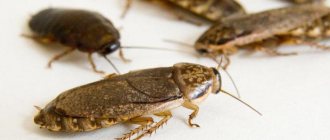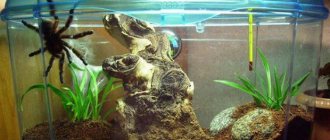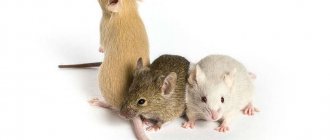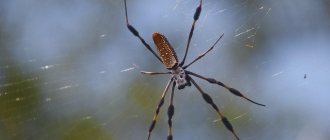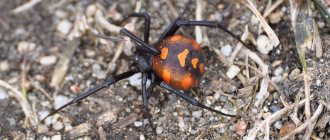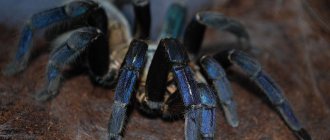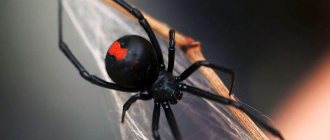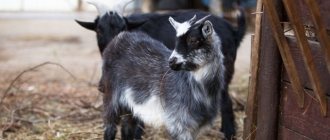Exotic animals are gaining rapid popularity among our compatriots. Today, many are interested in the possibility of breeding tropical birds, snakes, snails and other strange specimens at home. So, spiders are of great interest. From today's material you will learn what types of spiders you can keep at home. Do you want to know how to properly feed and care for exotics? Read on.
Types of house spiders
Spiders are an order of arthropods of the Arachnida class. There are more than 43 thousand varieties in nature. However, not all representatives of this order are suitable for life in captivity. In addition, many exotic species are dangerous to human health and life. We present to your attention a list of the most popular spiders for home keeping. Please note that the representatives of the Arachnida class listed below are distinguished by their noticeable appearance and impressive dimensions.
So, the types of spiders popular for home breeding are:
- bicolor tarantula;
- giant tarantula;
- striped tarantula;
- horned tarantula;
- white-haired tarantula;
- blue tarantula;
- Mexican red-legged tarantula;
- Costa Rican tiger tarantula;
- chrome tarantula;
- Acanthoscurria antillensis;
- Chromatopelma Cyaneopubescens;
- Brachypelma smitty;
- Brachypelma vagans and others.
Important information! Black widow - you've heard this name for a species of spider, haven't you? The redback spider secretes a neurotoxic venom that causes paralysis. Keeping this type of arthropod at home is extremely dangerous for human health and life!
Problem of choice
Not every member of the arthropod family can be accommodated in your home: some have an inconspicuous appearance, others are deadly poisonous and therefore pose a danger to people and animals.
The best spiders for the house are tarantula spiders. Large sizes, bright colors, shaggy bodies: tarantulas are distinguished by their excellent external appearance, which is why they attract the attention of lovers of exotic animals.
There are several species of tarantula spiders that you can keep at home. Each of them has its own characteristics.
Giant tarantula
Everyone decides for themselves, based on their taste and conditions, which spiders can be kept in their home, but most often the choice is the giant tarantula. It’s not called that for nothing: the leg span of an adult is at least 25 cm, and the body grows up to 10 cm in length. They are inactive, mostly sitting near their burrow.
Giant tarantula
Content Features:
- The size of the terrarium should be at least 30x30x30 cm.
- The thickness of the litter (coconut substrate or peat) must be at least 5 cm.
- The number of feedings per week is 2-3.
Important! The venom of giant tarantulas affects the human body quite aggressively, although it is not very toxic.
Bicolor tarantula
The leg span of adult representatives of this species can be about 16-17 cm, and the body length can be 7-8 cm. Females can live up to 20-23 years, while males live 5 times less. The peculiarity of two-colored tarantulas is their calm nature.
The maintenance features are almost the same as for giant tarantulas, but there are some differences:
- For bedding for two-color pets, it is better to use coconut substrate.
- Bicolor spiders are fed 1-2 times every 7 days.
Mexican red-legged tarantula
The leg span of spiders can reach 14-16 cm, and the body size is about 7 cm. Red-legged Mexicans live for more than 25 years. Peculiarities:
- The character is calm.
- They prefer to spend time near the hole.
- They eat once every 7 days.
Mexican red-legged spider
Other
There are several other types of tarantulas that are suitable for home keeping:
- White-haired. The leg span is over 16 cm, the body length is 7 cm. Life expectancy is 12-13 years for females, and 3 years for males. White-haired spiders are the safest to keep - they can be freely handled after feeding, as they only become aggressive when they are hungry.
- Striped. The leg span is 19-20 cm, the body length is up to 10 cm. The character is strictly individual - there are both aggressive and calm individuals.
- Horned. The leg span is 15 cm, the body length is 6-7 cm. The character is aggressive, so it is not recommended for beginners to keep spiders of this species.
- Blue. The leg span is 25 cm, the body length is 8-9 cm. It has a dangerous, not fully studied poison, so it is better for beginners to avoid keeping blue spiders at home.
- Chromic. Leg span is 16-19 cm, body length is 7-8 cm. Lives up to 20 years. By nature, these spiders are calm, but sometimes there are active, nervous individuals. The bite is toxic, although they rarely bite.
On a note! What type of spider to have at home is up to everyone to decide for themselves, but it is necessary to take into account not only its beautiful color and size, but also the characteristics of feeding, maintenance, and the level of danger.
Criteria for choosing a healthy pet
Unlike other purebred pets, spiders are not sold with documents and veterinary certificates. Therefore, when choosing an exotic predator for home breeding, you can rely solely on your own knowledge. For example, a healthy spider should be mobile. Pay attention to the number of paws. The absence of one or more legs is a characteristic sign of a sick arthropod. A healthy spider has a rounded abdomen. Lack of roundness indicates dehydration or prolonged starvation of the pet.
Choosing a pet
Since the role of a pet must certainly be a bright, eye-catching specimen, accordingly, the option with our practically “native” haymaker spider immediately fades into the background. And why disturb the cute eight-legged “neighbor” by driving him into a terrarium, besides, these creatures are already domestic and probably huddle in one (in most cases, several) of the cozy corners of your house. We’ll leave them there, and for home keeping we’ll choose someone nicer, for example, a tarantula. By the way, representatives of this particular species are the most common and popular spiders for home keeping. And there are several reasons for this:
- firstly, they are very beautiful - bright colors, large sizes, shaggy body;
- secondly, it reproduces well in captivity and, accordingly, is amenable to breeding;
- thirdly, it lives relatively long;
- fourthly, this species includes several hundred subspecies, which opens up a huge selection.
On a note! The venom of a tarantula spider is not fatal for an adult healthy person, but for other pets its bite can be fatal, for example, for cats, dogs, etc. In addition, tarantula venom can seriously undermine the health of a small child and a person with allergies!
However, tarantula spiders are far from the only representatives of their order that are chosen for home keeping. In addition to them, wolf spiders, often tarantulas, cross spiders and even baby jumping spiders are also in demand.
Criterias of choice
Having come to a pet store, say, for a kitten, we roughly understand what requirements to put forward for it: clean eyes, ears, a wet nose, etc. But what about the spider? What parameters should this creature advise?
So, let's examine the spider we like. It should be:
- Active. If it is absolutely immobile for a long time or moves very slowly, then most likely this specimen is sick.
- Healthy. The health of a spider is indicated by the state of its abdomen: when dehydrated, it becomes wrinkled; in a healthy arachnid, on the contrary, it is even and smooth. You should also pay attention to the condition of the hairs in this area - in a sick spider they will be of unequal size and combed in places.
On a note! When a spider is disturbed by painful sensations, it scratches its abdomen with its hind legs, tearing off some of the fibers!
- Small. A spider of particularly large size may turn out to be old, therefore, it will not illuminate your life with its presence for long. Also, remember that males are always slightly smaller than females.
- No visible damage to the body. However, here one should take into account the fact that some types of spiders may have broken off limbs that grow back after molting.
Choosing a container for house spiders
Domestic spiders feel comfortable in specially equipped terrariums. The container can be made of durable plastic, organic or tempered glass. For terrestrial and burrowing exotics, a horizontal type of structure is suitable, for tree spiders - a vertical one.
It is also important to correctly determine the size of the terrarium. A container that is too small can cause illness in your pet; a container that is too large can cause fear in the arthropod. The optimal dimensions for organizing a terrarium are 40x40 or 40x50 cm. But experienced spider keepers recommend adhering to the following principle: the width, depth and height of the container correspond to the two maximum spans of the spider’s legs.
10.Theridion grallator (Smiling Spider)
It is this spider that many arachnophobes would call the best in the world. It is absolutely safe for humans and has very small dimensions - the leg span is only 5 mm. It took tenth place in this ranking due to its cheerful coloring of bright colors. In addition, during the course of evolution, a real emoticon appeared on his body, similar to a face with a smile. So he can safely be called the most positive spider in the world. This coloring plays a protective function. Predators that eat spiders are confused at the sight of such bright colors, because they believe that it is poisonous. This gives him time to run and hide.
Optimal conditions of detention
Arrangement of the terrarium should begin with preparing the substrate. At first, you can use ordinary white toilet paper. In the future, we recommend purchasing a special substrate with increased hygroscopic properties:
- vermiculite,
- coconut substrate.
The height of the substrate for woody species of exotics is approximately 1-3 cm. Ground and burrowing varieties of spiders like to dig small holes, so form a substrate of coconut filler 5-6 cm high.
Air temperature. Spiders are considered heat-loving animals. Try to maintain the air temperature in the terrarium at 22-28 degrees Celsius. A short-term decrease in temperature to 15-18 degrees Celsius is allowed. But sharp jumps and prolonged drops in temperature can lead to illness and even death of the pet.
Humidity level. The maintained humidity range is determined by the type of house spider. For example, desert-shrub species of arthropods prefer dry air. The humidity in the terrarium should not exceed 75%. The optimal humidity level for tropical forest spiders is considered to be in the range from 75 to 95%.
Lighting. Spiders are nocturnal arthropods. They do not need additional lighting. Do you want to give your terrarium a special appearance using light? Place a small infrared lamp inside, which does not pose any harm or danger to your pet. It is prohibited to use incandescent lamps, since the conducted light dries the air and causes burns on the legs and other external organs of the spider.
Ventilation and tightness. Tightness plays an important role in the arrangement of the terrarium. The lack of a cover is the main reason for the “escaping” of spiders. However, do not forget that animals vitally need fresh air. Be sure to make small holes in the lid of the container for air circulation.
Decorative elements. The internal arrangement of a home involves the organization by a person of various “houses”, holes and other places for shelter. Inside the terrarium you can place coconut shells, voluminous stones, bamboo stems, dry branches, large fragments of clay flower pots, etc. Make sure that decorative elements are safe for spiders. Toxic paints, sharp corners, and cutting elements can injure pets.
Are house spiders dangerous to humans?
Due to the very unpleasant appearance of the uninvited tenant, a person automatically begins to wonder whether house spiders are dangerous. When answering, you need to clearly understand what is meant by the word “house”.
If we are talking about synanthropic species, then their representatives do not pose a threat to humans. When any spider found in a home is intended for domestic use, its danger is determined by its species.
For example, haylofts, which are often found in homes, are not even capable of biting a person on the skin, and the bite of a tarantula is painful and can cause serious deterioration in the well-being of a small child or a person prone to allergies.
Many people consider the ordinary house spider dangerous, but in fact these small creatures are very timid and try to hide at the first opportunity.
But regardless of the type, all spiders can be called dangerous, if only because they can cause the development of arachnophobia in one of the family members or its aggravation in those who have suffered from this pathology for a long time.
Accessories and equipment necessary for keeping spiders
Breeding spiders at home requires special equipment and accessories. We list some of the elements that will be needed for keeping, feeding and caring for exotics:
- terrarium made of plastic or glass;
- filler (substrate);
- decorative elements;
- sippy cup;
- thermometer;
- air heater;
- additional lighting device;
- a small container with a lid to isolate the pet;
- tweezers 20-25 cm long for feeding;
- long brush for transplanting an animal.
How to feed a tarantula spider
As for the spider's nutrition, it has its own characteristics. It must be fed with live food. You can feed young individuals once every two or even three days, and adult tarantula spiders once every two weeks.
The food should not exceed the size of the spider, otherwise it will be difficult for it to digest the prey. The basis of the tarantula's diet in apartment conditions is mealworms, crickets, marbled cockroaches, and zoophobes.
The food supply can also be bred at home, in plastic containers. Or buy from more experienced breeders who breed food for their animals. It is also necessary to ensure that tarantula spiders and pets always have constant access to clean water. It is not difficult to find a drinking bowl in a pet store or, if desired, to make it yourself from available materials.
In conclusion, it is worth emphasizing that absolutely all spiders are poisonous. Therefore, when communicating with a tarantula spider, even the calmest one, it is not recommended to pick it up. By the way, when cleaning the terrarium and feeding, use long tweezers.
The poison does not pose a mortal danger to humans. But the poisonous hairs with which the spider is covered can cause unpredictable allergic reactions if it comes into contact with the skin. In addition, the spider may be stressed! For example, finding yourself in an unusual environment outside the terrarium, with conditions created suitable for it.
The maintenance of different species of tarantulas can vary significantly depending on the specific species, but is generally similar. The decision on which of the many commercially available tarantulas to place in your home is, of course, made by the future owner, based on personal preferences.
Recommendations for caring for the terrarium
Also, the advantages of raising spiders as pets include the absence of difficulties with care. General cleaning of the terrarium with a complete replacement of the substrate is carried out once every 6-12 months. During the cleaning period, the pet is transplanted into a separate small container.
Regular care of exotics involves timely and proper feeding and monitoring the availability of water in the drinking bowl. When choosing a sippy cup, check with the seller for the dimensions: the container should be smaller than your pet. Otherwise the spider may drown! Also, do not forget to remove leftover food, monitor the humidity level and temperature conditions inside the terrarium. To increase the level of humidity, experienced spider keepers recommend using a medical syringe (without a needle!) or a watering can with a thin “spout”.
Getting rid of arthropods
The task is easy. It is enough to carry out a general cleaning, collect all the existing cobwebs and thoroughly rinse all the corners and seal all the cracks in the house. Ventilating the room will also have a great effect on the “leakage of uninvited guests.” Throwing out garbage and unnecessary rubbish can also work to your advantage.
Chemical repellents for spiders.
Arthropods will not tolerate chemicals. The following remedies will help you get rid of it:
- Butox 50.
- Dichlorvos.
- Neoron.
- Dobrokhim FOS and others.
Children and pets should leave the premises before spraying chemicals. Having chosen a product and treated your apartment with it, you should also leave the room for 30–40 minutes so as not to breathe in fumes and chemicals. After cleaning, the room should be well ventilated.
Important! You shouldn't resort to chemicals if you don't have many arthropods. Use chemicals when you realize that general cleaning will not bring good results.
Folk remedies.
In addition to chemistry, there are wonderful remedies “from the people”.
- A vacuum cleaner will carefully remove all the eggs laid by arthropods and collect all the cobwebs, and to eliminate the individuals themselves, use sticky traps, simply place them around the entire perimeter of the apartment.
- Essential oils of eucalyptus, mint and tea tree will also save you from unpleasant creatures.
How to prepare the solution?
- 20 drops of your chosen essential oil.
- 500 milliliters of water.
Mix the resulting solution and apply to the areas where arthropods live.
Rules for feeding a house spider
Domesticated spiders are predators, so they must be fed with animal products. The most rational option is to purchase food in specialized stores. Food includes mealworms, larvae, Argentine, marbled or Turkmen cockroaches.
Helpful advice! You should not feed house spiders flies, bugs, cockroaches and other insects that you caught yourself. These types of insects can carry various viruses and infections, which will have a detrimental effect on the well-being and health of the pet.
The frequency of feeding depends on the age of the house spider. Young individuals are fed 3-4 times a week, adults - 1-2 times. Moreover, the animal may refuse to eat during the molting period or during a sharp drop in temperature. We strongly do not recommend leaving food or its particles in the terrarium. Also keep an eye on the “portion” size – no more than a third of the spider’s body.
Reasons for the appearance of spiders in an apartment or house
Only some species of spiders are synanthropic, that is, they live near people. For most species, being in a human home is unnatural; their habitat is wild nature.
There are several main reasons why arachnids appear in houses and apartments.
Between them:
- an abundance of food (since spiders feed on insects, beetles, flies, mosquitoes, midges, and even insects in the house will attract eight-legged predators);
- adequate temperature and humidity (spiders climb into the house, attracted by warmth, run away from cold, excessively dry air or, conversely, high humidity).
The randomness factor is also of great importance. The spider may enter the house with a bouquet of flowers or a basket of vegetables from the garden, on a person's clothing or on the fur of a pet. A common situation: in the summer, an arthropod crawls into the house through an open window or door.
Reproduction of spiders, features
The spider's reproductive organ is located in front of the spinning organ . After mating, the male is often extremely careful, since some species of females are capable of killing their sexual partner and using him for food.
This is interesting! Males of some common species after mating do not care at all about their safety and absolutely calmly allow the female to eat them, and some species are capable of living together for a long time.
A few weeks or months after mating, the female begins to make a special cocoon, which she can move around the terrarium in search of the most comfortable conditions. At a certain time, the female independently opens the cocoon and many tiny spiders are born.
Return to content
Brazilian spider crab
A uniquely shaped body with numerous protrusions and the ability to adapt to its surroundings help these spiders hunt insects. Their belly color is usually white, sometimes with a pinkish or blue tint. Habitat: Latin American countries. The Brazilian spider crab is best at pretending to be a tropical flower, misleading its potential prey.
9.Latrodectus mactans (Black Widow)
The ninth place among the most beautiful spiders on the planet is occupied by Black Widows. They account for many human lives. A Black Widow bite most likely leads to death or serious health consequences if an antidote is not administered in time. This is despite its small size - a maximum of two centimeters in diameter. The spider got its name because the females of this species eat the males after mating. Their appearance is not distinguished by very bright colors; it can even be called modest. The abdomen is painted black with a matte sheen, and has small red spots on it. This simplicity looks quite beautiful.
